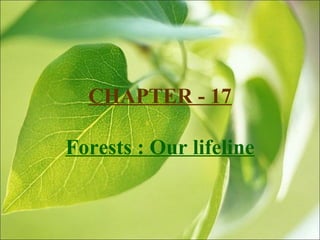
17forestsourlifeline
- 1. CHAPTER - 17 Forests : Our lifeline
- 2. 1) Forest :- Forest is a natural habitat for many different kinds of plants and animals. Forests provide food and shelter for animals. Some common animals found in a forest are :- lion, tiger, elephant, monkey, deer, zebra, jackal, bison, boar, snake, porcupine, crocodile etc.
- 3. Some common types of plants found in forests are :trees like teak, bamboo, fig, saal, sesham, semal, neem, palash, khair, amla, kachnar etc. Forests also have several kinds of shrubs, herbs and grasses, climbers, creepers etc. TEAK BAMBOO FIG SHEESHAM SAL NEEM AMLA KACNAR
- 4. 2) Products we get from forests :- We get several useful products from forests like wood, spices, gum, oils, honey, sealing wax, catechu, fodder for animals, medicinal plants etc.
- 5. 3) Characteristics of trees in forests :- The branchy part of a tree above the stem is called the crown of the tree. The crown of trees have different shapes. Some crown shapes of trees The branches of tall trees look like a roof over the other plants in the forest. This is called a canopy. Trees have different heights, crowns, shapes of leaves, flowers and fruits.
- 6. 4) Interdependence of components of forest :- Forest has different types of plants and animals. They are autotrophs, heterotrophs, saprotrophs and decomposers. Autotrophs:- are green plants which prepare food by photosynthesis. Heterotrophs:- are animals which get their food directly or indirectly from plants. Saprotrophs:- are animals which feed on dead animals. Decomposers:- are micro organisms which decompose dead plants and animals into humus. Food chain:- Organisms which feed on plants are eaten by other organisms and so on to form food chains. eaten by eaten by eaten by eaten by Eg : Grass Insects Frog Snake Eagle There are many food chains in the forest. All food chains are linked together. If any food chain is disturbed, it affects other food chains. Every component of forest depends on one another. If we remove one component like trees, all the other components are affected.
- 7. 5) Balance of oxygen and carbon dioxide in the atmosphere :- During respiration plants and animals take in oxygen and release carbon dioxde. During photosynthesis plantstake in carbon dioxide and release oxygen. So plants help to maintain the oxygen and carbon dioxide balance in the atmosphere. This is why forests are called green lungs. Oxygen Plants Animals Carbon dioxide
- 8. 6) Importance of forests :- i. Forest is a natural habitat for a large number of plants and animals. ii. Forest help in maintaining the oxygen and carbon dioxide balance in the atmosphere. iii. Forests help in bringing good rainfall. iv. Forest help to protect soil from erosion. v. Forest absorb rainwater and helps to maintain water table. vi. We get medicinal plants, timber and many other useful products from forests. vii. Many people live in forests and forest provide them with food, water, shelter and medicines.
